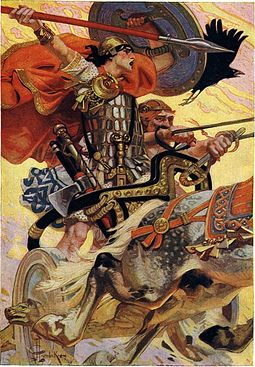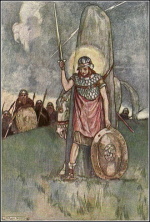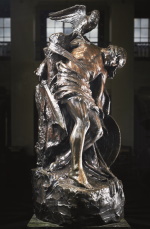Ancient Irish Standing Stone and Death of Cúchulainn

Cú Chulainn or Cúchulainn is said to be the son of Lugh, a god in Irish mythology and member of the pre-Christian Gaelic pantheon the Tuatha Dé Danann. The Tuatha Dé Danann form a significant feature in Irish, Scottish and Manx mythology who had supernatural ability and were of great importance to the belief systems of the Gaelic people. In the Ulster Cycle, one of the four great cycles of Irish mythology, Lugh fathered Cú Chulainn with the mortal maiden Deichtine who was the sister of Conchobar mac Nessa the king of Ulster. Cúchulainn is the principal character of the epic Irish saga the Táin Bó Cuailgne commonly known as The Cattle Raid of Cooley or The Táin which is traditionally set in the 1st century AD.

Although the life of Cúchulainn was short, his great deeds and ability as a warrior has resulted in his fame lasting many centuries. His reputation at the time was such that he was greatly feared by his enemies. In the Ulster Cycle, Lugaid mac Con Roím whose father had been killed by Cúchulainn, conspired with Medb Queen of Connacht and the children of other people Cúchulainn had killed to defeat him. It was Lugaid's spear that caused the mortal injury to Cúchulainn. Even at the time of his death his enemies were frightened to approach him.

According to legend, the fatally wounded Cúchulainn tied himself to the Clochafarmore standing stone so that he could stay upright and face the opposing army even in death. His enemies feared he was still alive. It was not until Morrigan (the Celtic goddess of War and Death) appeared in the form of a raven and landed on his shoulder that they were sure he was dead. At this stage Lugaid approaches and cuts off the great hero's head. Although it is said that as he does this the "hero-light" burns around Cúhulainn and his sword falls from his hand and cuts Lugaid's hand off. Cúchulainn’s death was avenged by another great Irish mythological hero Conall Cernach who had a pact with him that whoever was killed first, the other would avenge him. The story has it that Conall took Lugaid's head and set it on a stone, but his blood melted the stone and the head sank right through it.

The story of the warrior hero Cúchulainn has been drawn on by many of those who fought for Irish freedom and political independence. It was Irish sculpter Oliver Sheppard’s 1911 bronze statue of Cúchulainn dying in battle, that was chosed to serve as the official memorial to the Easter Rising in the run-up to its 20th anniversary in 1935. The installation of “The Dying Cúchulainn" stands at the GPO building in Dublin, the headquarters of the Rising in 1916. The site thought of as that of the death of Cúhulainn, the Clochafarmore (Irish: Cloch an Fhir Mhóir) standing stone can still be seen. It is located about 1.4 km (0.87 mi) east-northeast of the village of Knockbridge (Irish: Droichead an Chnoic) which is about 5.5km south-west of Dundalk (Irish: Dún Dealgan) on the left bank of the River Fane, County Louth, Ireland (Irish: Abhainn Átha Féan, Contae Lú, Éire).
Content type:
- Irish
Language:
- English





